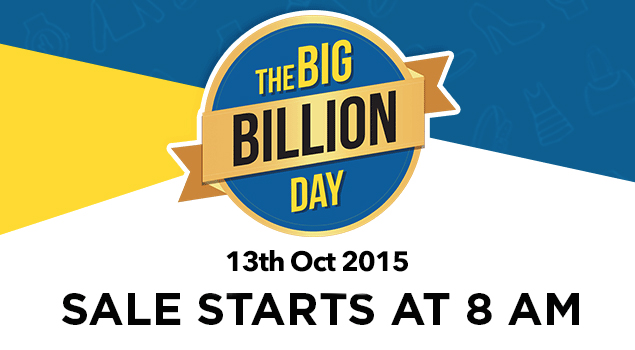Finally,
Flipkart’s a lot of anticipated “big billion day” for the year 2015
is declared. This year, it's slated to be from thirteenth(13th) to seventeenth(17th) Oct. It's about
to be attention-grabbing considering 2 e-commerce giants Amazon and Flipkart would roll out
offers throughout constant timeline. You can explore massive Billion
Day offers and coupons to get max of whatever offered at
Flipkart.
Big Billion Day 2015 Offers and Coupons
Last year, the massive billion day sale from Flipkart raised eyebrows and
users were umbrageous concerning the
frequent crashes. That shocked the
corporate and as a result, its founders offered
associate degree apology to the
purchasers. This year, Flipkart is claimed to own scaled
up everything to handle high traffic flow, and at this significant juncture, it's in no mood to loose against its chief rival Amazon, that has been learning steady and creating forays into the Indian client base.
Flipkart Big Billion Day – This year it is only through app
Yes! You got it right, this year, Flipkart has confined the sale to the app. This sale would not be extended to the stuff you buy from the website, therefore to take advantage of the big billion day sale 2015, you need to install Flipkart mobile app, which is available on all platforms.
Why has Flipkart kept it app only sale?
There are several reasons for it, and one is the long-standing desire of the company to switch over to an app only portal like Myntra. Earlier many pundits said that Flipkart would switch to an app only model from October onwards, but it was a claim that was never materialized. But with this sale, both Flipkart and its chief rival Amazon have proved that they are strongly leaning towards app only model and are prepared to incentivize users who are ready to do so. Of course, it is a long term strategy, but Flipkart seems to be taking baby step towards the grand strategy.
Things you can expect in Big Billion Day Sale 2015
While Flipkart keep such things classified there are quite a number of things that you can expect from the big billion day sale. Discounts on big items, like television, laptops and other electronic and utility items. Not only they are expected to give up discounts, but would also improve the delivery time frame, so don’t be surprised if you either see a regular time frame for delivery or an expedited delivery at low rates. Smartphones, flash drives, hard drives etc. It would also include low prices on tablets and other gadgets. LED Bulbs, books, and media are likely to be discounted in this edition of sale. Home and furniture discounts could range to 10-15% lower than what it is now. Products in all other categories might be discounted by 10%. Cashback on certain cards, especially HDFC, CityBank, Standard Charted, SBI and Axis bank is expected.
This time SELLERS are prepared
Flipkart has worked overtime to ensure that sellers are prepared and have backup plan for everything – including handling high volume of orders, coordinating with logistics etc., and has not kept a stone unturned to make sure that it wins customer loyalty this time around.
One important thing that Flipkart has done this time is that it is imparting a special four-hour training to the sellers to educate their sellers about how to manage inventory during the peak demand.
It is said that Flipkart has reached out to 6000 of its sellers to ensure that customers get a flawless ordering experience.
It is said that Flipkart has reached out to 6000 of its sellers to ensure that customers get a flawless ordering experience.
Explained in steps: How you can take advantage of the sale
- Step 1 – Download the Flipkart mobile app, it is available on both Apple and Android platforms.
- Step 2 – Have a wish list ready even before the sale, Remember everyone would just get onto Flipkart to buy, and although the steps taken by Flipkart are reassuring, it doesn’t guarantee that it wouldn’t happen again.
- Step 3 – Save your personal information, both your address and funding source, because last year, the products were reported out of stock by the time users proceeded to check out. To save you from disappointment, save it all so that you are all set on the sale day.
- Step 4 – If you have multiple credit cards, put them all, because often such sales are complemented with generous cash back offers from the bank, so make sure that you are set, and on the sale day, choose card that gives you best cashback offer.
If you run into any problem
- 1. Contact customer service, through facebook, twitter or through the app.
- 2. Be patient, there can be a delay considering that they have a huge user base to manage. And lots of sales means lots of complaints.
- 3. Be considerate and provide details as the support guys request you. Companies do run on customer service and it is very unlikely that any company would want to lose customers due to bad customer service.
Word of caution for Flipkart
Last time, there was a hue and cry over the failure of big billion day sale, many complaints were lodged, and there was a considered damage to the brand value. Although Flipkart has acted to allay the fears of the users, they need to treat everything with great sensitivity, because Indian customers may forgive a one-time error, but repetitive mistakes would lead to even more damage to the brand.
Big Billion Day 2015 is a great arena for two e-commerce giants to fight for the top slot, while Flipkart has an edge over amazon in terms of user base, Amazon is steadily picking up by putting up discounts and complementing it with great customer service.




